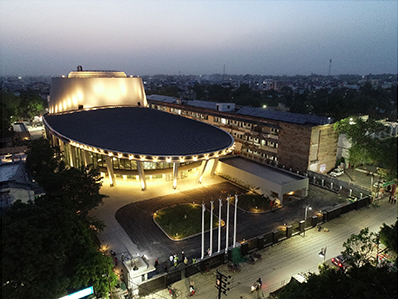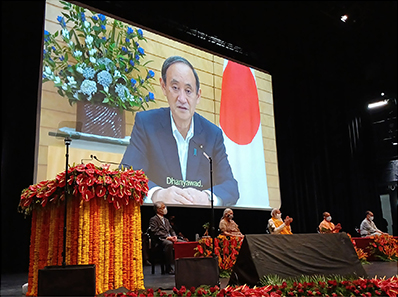Stories from the Field 05
Constructing an International Convention Center as a Hub for Cultural and Human Exchange in a Holy City of India

An aerial view of the International Cooperation and Convention Center in Varanasi (Photo: JICA)

Indian Prime Minister Modi (third from the right) attending the opening ceremony and then Prime Minister Suga delivering a video message (Photo: JICA)
India has many attractive tourist spots that draw people from all over the world, and tourism is one of the industries driving the country’s economic growth. Varanasi City in the State of Uttar Pradesh has a history of approximately 3,000 years and receives approximately 7 million visitors a year from India and abroad for both pilgrimages and tourism. The city holds many tourism and cultural events, but it was a challenge that there were no facilities that could accommodate a large number of people.
In response to the expectation expressed by Prime Minister Modi at the Japan-India Summit Meeting in 2015 for the development of a convention center in Varanasi City, Japan decided to implement the “Project for Construction of the International Cooperation and Convention Center in Varanasi (VCC)” through grant aid.
The construction work, which started in 2018, faced unique local challenges. “People in India have a different sense of time compared with ours. They would not start preparations and arrangements for the next process before the current ones were complete. Therefore, there was room to improve work efficiency. We had to constantly monitor and take the initiative to start making arrangements for the next process,” said Mr. TABATA Mitsugu of Fujita Corporation, who oversaw the construction site, talking about the situation at the time. The spread of COVID-19 also had a major impact on the construction. “One day, suddenly the whole city was locked down. We had no idea when the lockdown would be lifted, and we could not even get close to the project site for a long time.”
While overcoming these various challenges, the VCC was successfully completed in 2021. The completed VCC has a Main Hall with a seating capacity of 1,200 people and the latest stage and sound equipment, as well as conference rooms and dressing rooms. The design incorporates beautiful curves inspired by Hindu symbols, and it has become an unprecedented symbolic building that is unique and embodies Indian culture. “I think that we made the most of Japan’s high technical capabilities in this highly difficult construction of a building with many curves,” said Mr. OTA Masataka of Fujita Corporation. The project also provided management know-how in general, including how to operate stage equipment and how to plan cultural events.
For the opening ceremony held in July 2021, Prime Minister Modi and the Chief Minister of Uttar Pradesh attended from the Indian side, while then Prime Minister Suga provided a video message from the Japanese side. With the hope that the completed VCC would become a symbol of Indian wisdom, Prime Minister Modi gave the center the nickname “Rudraksh” (meaning bodhi fruits).
India assumes the G20 Presidency in 2023, and various meetings are scheduled nationwide. In addition to holding such international conferences, the VCC can also host large-scale events for cultural and citizen exchanges. As a result, the number of visitors with purposes other than conventional tourism will increase, and it is expected that this will contribute to the development of the city through international exchanges and further tourism promotion.
<< Previous Page Next Page >>
Main Text | Reference Statistics | Appendix | Stories from the Field | Master Techniques from Japan to the World | ODA Topics
